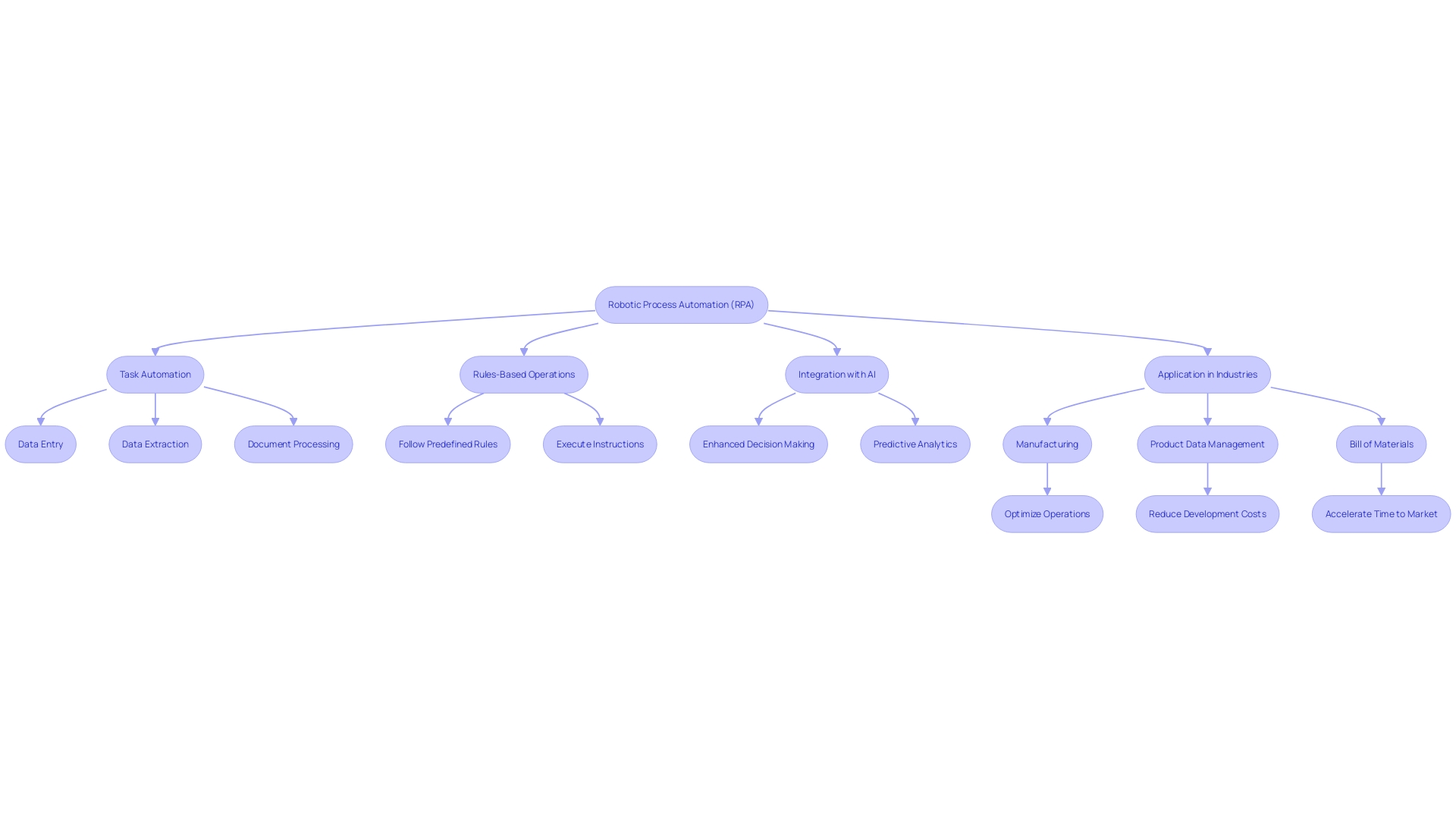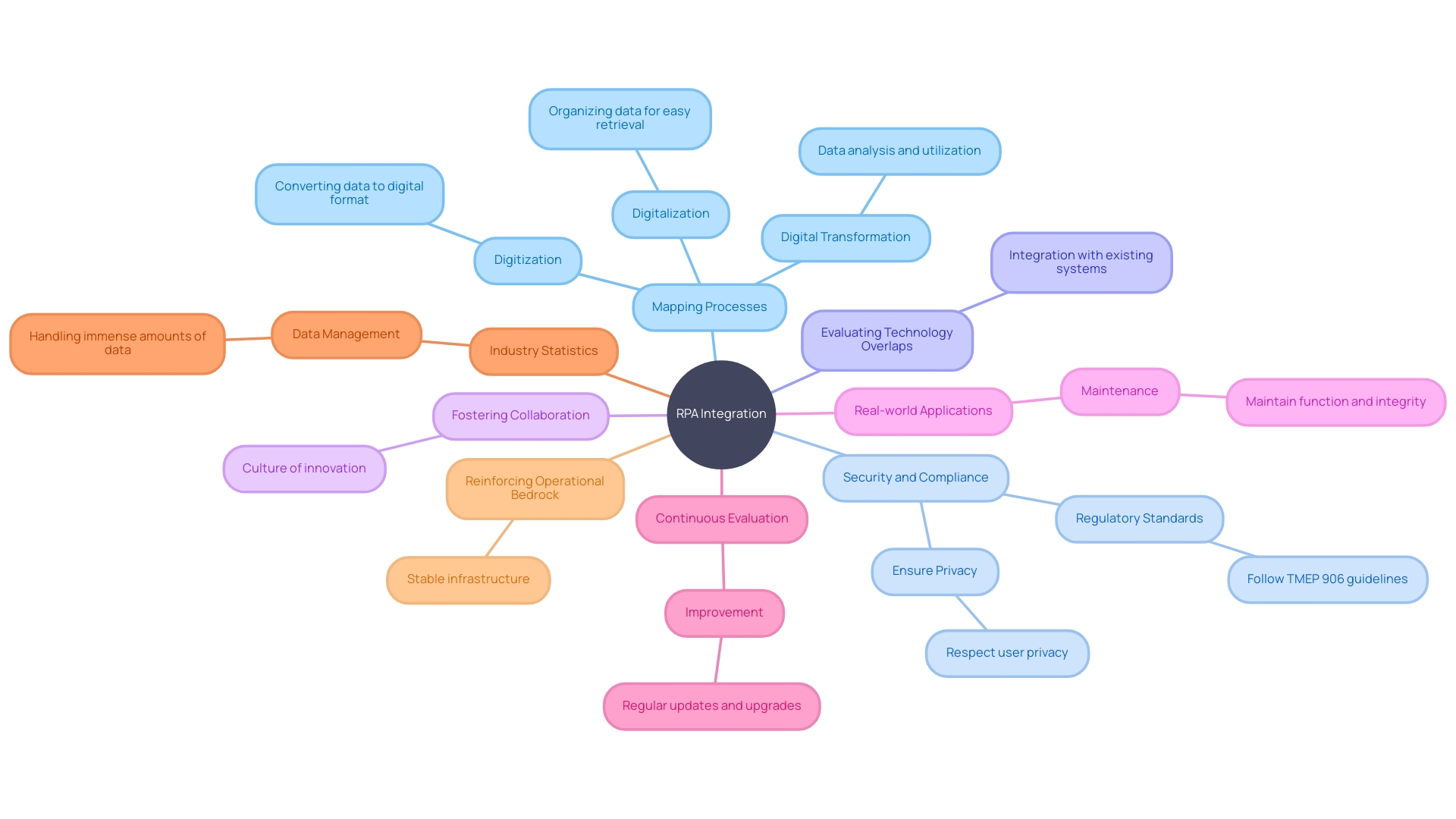Introduction
Robotic Process Automation (RPA) is transforming the way businesses operate by automating repetitive tasks through the use of intelligent software robots. With the ability to emulate human interactions with digital systems, these bots execute tasks with remarkable speed and precision, enhancing process efficiency, reducing costs, and boosting productivity. RPA’s versatility is evident across various industries, from eyewear retail to winemaking, where it streamlines operations and improves customer care.
RPA works in tandem with other facets of Artificial Intelligence (AI) to minimize errors and enhance communication fluidity. This article explores the benefits of RPA in enhancing efficiency and accuracy, identifying suitable processes for automation, and providing strategies and best practices for planning and implementing RPA. As businesses strive for operational excellence, RPA emerges as an indispensable tool in their arsenal of modern business strategy.
Understanding RPA: Definition and Context
Robotic Process Automation, commonly known as RPA, is revolutionizing the way businesses operate by empowering them with the ability to automate mundane, repetitive tasks through the use of intelligent software robots, or bots. These bots are adept at emulating human interactions with digital systems and applications, thereby executing tasks with remarkable speed and precision. The increase in RPA adoption is due to its significant impact on improving efficiency, reducing operational costs, and greatly enhancing overall productivity.
The versatility of RPA is evidenced by its applications in various industries. For instance, Specsavers, the renowned eyewear retailer, utilizes RPA to navigate the intricacies of its vast supply chain and the unique demands of optometry, where traditional machinery often lacks modern connectivity. This enhances early identification of potential health issues, thus enriching customer care. Similarly, St. James Winery leverages RPA to maintain its position as Missouri’s premier and most decorated winery, streamlining processes to ensure consistent quality across competitions.
Further solidifying the relevance of RPA, the OODA network of international experts integrates it into a suite of services that include intelligence analysis, strategic planning, and crisis management for corporations and governments worldwide. This reflects the extensive range of RPA, extending beyond basic task execution to encompass strategic operations.
RPA’s role is not isolated; it works in tandem with other facets of Artificial Intelligence (AI), such as machine learning and natural language processing, to heighten operational intelligence. By automating workflows, companies are able to minimize human error and enhance communication fluidity, which is crucial in sectors where precision and timeliness are paramount. The technology is not just about replacing human effort but augmenting it with enhanced reporting, analytics, and a relentless drive for continuous improvement.
As the CTO and Co-Founder of Reveille Software puts it, automation has always been about enhancing productivity and convenience, and RPA, with its software bots, is the latest evolution in this ongoing narrative of innovation. It’s a collaboration between human oversight and robotic efficiency that drives organizations forward into a more effective future. The landscape of RPA is dynamic, and as it evolves, it promises to redefine the operational capabilities of industries, making it an indispensable tool in the arsenal of modern commercial strategy.
Benefits of RPA: Enhancing Efficiency and Accuracy
Robotic Process Automation (RPA) represents a significant advancement in the journey of innovation that started with the earliest mechanization tools like water wheels and windmills. Today, RPA represents a sophisticated form of business automation that leverages software bots to execute repetitive, rule-based tasks across various industries, effectively transforming operational efficiency. These software applications, or ‘bots’, are capable of mimicking human actions on computer systems, performing tasks such as data entry, data extraction, and document processing with precision and reliability.
By integrating RPA, organizations can delegate mundane activities to virtual assistants, much like the AI assistant Lindy, which has been designed to handle a plethora of tasks across multiple applications. This not only optimizes operations but also greatly minimizes the risk of human error, thereby improving accuracy in critical procedures. For example, companies like Delivery Hero have employed RPA to tackle recurring operational bottlenecks such as the account recovery procedure, which previously took 35 minutes per incident, resulting in a significant decrease in productivity with 800 such occurrences every month.
Furthermore, advancements in AI technology, as demonstrated by the Korea Institute of Machinery and Materials, are now being integrated into manufacturing processes, showcasing the dynamic applicability of RPA in various workflows. The technology’s rules-based nature ensures that tasks are executed consistently, and when coupled with continuous improvement practices, it paves the way for a future where hyperautomation becomes a strategic imperative for large organizations. RPA’s implementation in industries like Coding Crafts extends even further, incorporating blockchain development services to add layers of security and transparency.
The strategic deployment of RPA can yield significant benefits, as automating product data management and bill of materials has shown to reduce product development costs and accelerate time to market. In a world where efficiency and rapid innovation are crucial, RPA enables businesses to concentrate on high-value opportunities, promoting a vision where the future of work is consistently optimized and enhanced by intelligent technology.

Identifying Processes for RPA: Assessing Feasibility and Suitability
When contemplating the adoption of Robotic Process Automation (RPA), it is crucial to carefully assess the procedures within your company that are ready for mechanization. Factors like the rule-based nature of the procedure, the complexity, and the volume of transactions are crucial in determining a procedure’s appropriateness for RPA.
For example, Surrey County Council’s adoption of automation to manage services for over a million residents highlights the significance of choosing the appropriate procedures to enhance service delivery and efficiency. Similarly, the NHS’s procedure for vetting new digital technology requests emphasizes the necessity of understanding existing capabilities before introducing new automated solutions.
Furthermore, the importance of AI and Machine Learning in improving business operations cannot be denied. A systematic review by Mostafa Abbasi and colleagues reveals the transformative impact of these technologies in process management. As technology advances, organizations like Coding Crafts are at the forefront by integrating Blockchain with RPA, offering a new dimension of security and transparency.
In terms of privacy and ethical considerations, the deployment of RPA must be handled with care. Reports on the regulation of AI in autonomous weapons and the potential misuse of algorithms in rent pricing emphasize the wider implications of technology and the need for responsible implementation.
Statistical insights from data science surveys, such as the one conducted by Eric Siegel, Ph.D., inform us about the prevalent challenges and future directions in deploying machine learning, which is closely related to RPA initiatives. These insights assist in evaluating the preparedness of an organization’s procedures for successful RPA implementation.
Planning and Implementing RPA: Strategies and Best Practices
Embarking on the journey of integrating Robotic Process Automation (RPA) into your organization’s framework is akin to navigating a complex digital transformation. It begins with a detailed plan for mapping processes, which is a phase where organizations identify and outline the particular workflows that can gain advantages from mechanization. Drawing from the experiences of M&T Bank, which faced the challenges of digital transformation in the banking sector, it’s clear that ensuring the security and compliance of the software is paramount. This proactive action is not only about avoiding costly obstacles; it’s about ensuring the integration enhances the foundation of your operations.
The deployment of RPA bots should be approached with a similar mindset to that of the NHS Digital Service Team—evaluating the appropriateness, security, and compliance of the technology. It’s about digging deeper to understand the technology and its potential overlaps with existing solutions, thereby avoiding redundancy and leveraging existing digital assets.
Change management, a critical facet of RPA integration, involves more than just implementing new technology. It means fostering a culture of collaboration, much like the ethos at Rackspace Technology, where the respect for individual preferences and roles in the broader system contributes to a harmonious and efficient environment.
In terms of best practices, it’s essential to consider the real-world applications of RPA. For instance, automating tasks with AI and developing process models for intelligent automation are not about replacing human labor but enhancing human-machine collaboration. The journey to a successful RPA implementation is a constant cycle of evaluation and improvement, ensuring the bots adapt to the evolving needs of services—a principle that has been reiterated in recent news about the dynamic nature of manufacturing systems.
Supporting this approach with industry statistics, experts like Dr. Evan Shellshear emphasize almost two decades of adapting AI tools across various industries, underscoring the importance of continuous refinement in the face of diverse applications. Moreover, the survey of data science and analytics professionals, as reported by Eric Siegel, Ph.D., highlights the multifaceted challenges and future directions in the field, including those pertinent to RPA deployment.
Ultimately, every step of planning and implementing RPA is an opportunity to reinforce the operational bedrock of your organization. It’s about ensuring that each RPA bot is not just a standalone solution but an integral part of a system that operates with the precision and efficiency your business strives for. As the Robotics & Automation Awards approach, the industry’s focus on innovation serves as a reminder of the continuous drive toward operational excellence that RPA embodies.

Conclusion
In conclusion, Robotic Process Automation (RPA) is a transformative tool that enhances operational efficiency by automating tasks and improving accuracy. It streamlines processes, reduces costs, and boosts productivity across industries.
RPA works alongside other AI technologies to minimize errors and improve communication, enabling organizations to focus on high-value opportunities and accelerate innovation. When implementing RPA, it is crucial to identify suitable processes based on their rule-based nature, complexity, and volume of transactions, while also considering privacy and ethical considerations.
Planning and implementing RPA require a strategic approach, including process mapping and evaluating the appropriateness, security, and compliance of the technology. Change management and fostering a collaborative culture are critical for successful integration.
Continuous evaluation and improvement are key to a successful RPA implementation. The bots must adapt to evolving service needs and align with industry trends. Industry statistics and insights emphasize the importance of continuous refinement and adaptation.
In conclusion, RPA is an indispensable tool that reinforces operational excellence. It combines human oversight and robotic efficiency to drive businesses towards enhanced productivity and success. As RPA evolves, it will continue to redefine the operational capabilities of industries and become an essential component of modern business strategy.

